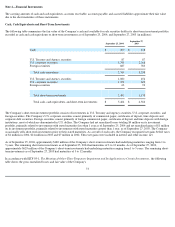Apple 2004 Annual Report Download - page 80
Download and view the complete annual report
Please find page 80 of the 2004 Apple annual report below. You can navigate through the pages in the report by either clicking on the pages listed below, or by using the keyword search tool below to find specific information within the annual report.
potential accounting loss on these transactions if all counterparties failed to perform according to the terms of the contract, based on then-current
currency exchange rates at each respective date. The Company's exposure to credit loss and market risk will vary over time as a function of
currency exchange rates.
The estimates of fair value are based on applicable and commonly used pricing models using prevailing financial market information as of
September 25, 2004 and September 27, 2003. In certain instances where judgment is required in estimating fair value, price quotes were obtained
from several of the Company's counterparty financial institutions. Although the table above reflects the notional principal, fair value, and credit
risk amounts of the Company's foreign exchange instruments, it does not reflect the gains or losses associated with the exposures and
transactions that the foreign exchange instruments are intended to hedge. The amounts ultimately realized upon settlement of these financial
instruments, together with the gains and losses on the underlying exposures, will depend on actual market conditions during the remaining life of
the instruments.
Foreign Exchange Risk Management
The Company may enter into foreign currency forward and option contracts with financial institutions to protect against foreign exchange risk
associated with existing assets and liabilities, certain firmly committed transactions and forecasted future cash flows. Generally, the Company's
practice is to hedge a majority of its existing material foreign exchange transaction exposures. However, the Company may not hedge certain
foreign exchange transaction exposures due to immateriality, prohibitive economic cost of hedging particular exposures, or limited availability of
appropriate hedging instruments.
To protect gross margins from fluctuations in foreign currency exchange rates, the Company's U.S. dollar functional subsidiaries hedge a portion
of forecasted foreign currency revenues, and the Company's non-U.S. dollar functional subsidiaries selling in local currencies hedge a portion of
forecasted inventory purchases not denominated in the subsidiaries' functional currency. Other comprehensive income associated with hedges of
foreign currency revenues is recognized as a component of net sales in the same period as the related sales are recognized, and other
comprehensive income related to inventory purchases is recognized as a component of cost of sales in the same period as the related costs are
recognized. Typically, the Company hedges portions of its forecasted foreign currency exposure associated with revenues and inventory
purchases over a time horizon of 3 to 9 months.
Derivative instruments designated as cash flow hedges must be dedesignated as hedges when it is probable that the forecasted hedged transaction
will not occur in the initially identified time period or within a subsequent 2 month time period. Deferred gains and losses in other
comprehensive income associated with such derivative instruments are immediately reclassified into earnings in other income and expense. Any
subsequent changes in fair value of such derivative instruments are also reflected in current earnings unless they are redesignated as hedges of
other transactions. During 2004, the Company recorded net losses of $2.8 million in other income and expense related to the loss of hedge
designation on discontinued cash flow hedges due to changes in the Company's forecast of future net sales and cost of sales and due to prevailing
market conditions. No net gains, or losses, of a similar nature were recorded in 2003. During 2002, the Company recorded net gains of
$2.5 million in other income and expense related to the loss of hedge designation on discontinued cash flow hedges due to changes in the
Company's forecast of future net sales and cost of sales and due to prevailing market conditions. As of September 25, 2004, the Company had a
net deferred loss associated with cash flow hedges of approximately $4.4 million, net of taxes, substantially all of which is expected to be
reclassified to earnings by the end of the second quarter of fiscal 2005.
76
























